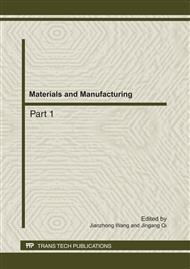p.1091
p.1095
p.1099
p.1103
p.1107
p.1111
p.1115
p.1120
p.1124
Effect of Tempering Holding Time on Performance of Wear-Resistant Steel of High Pressure Blower Impeller
Abstract:
As ventilation and dust removal equipment, high pressure blower is widely used in industry, but the heavy wear of impeller which is the core frame member of the equipment still restrict the fully increasing in the performance of the high pressure blower. So it has important significance to research and develop wear-resisting impeller of high pressure blower. The article focused on studying the microstructure and hardness of the experimental steel used in the wear-resisting impeller of high pressure blower, subjected to be processed in different tempering holding time; as well as analyzing the mechanism of the influence of tempering holding time on the experimental steel. The results show that, with the increasing in holding time, lath-shaped tempered martensite becomes obscure in experimental steel used in the Q-tempered wear-resisting impeller of high pressure blower, as well as the account of acicular martensite and bainite also increases, resulting in the gradual decreasing in hardness. Furthermore, the hardness of alloy steel decreases sharply when the holding time is more than 60 min. Thereby, the best holding time of alloy steel is considered to be 40 to 60 min.
Info:
Periodical:
Pages:
1107-1110
Citation:
Online since:
July 2011
Authors:
Price:
Сopyright:
© 2011 Trans Tech Publications Ltd. All Rights Reserved
Share:
Citation:


